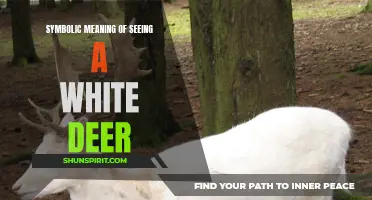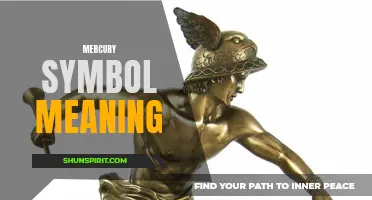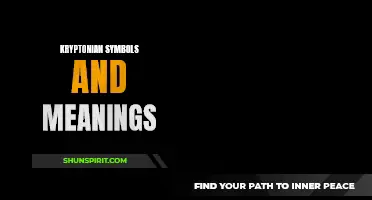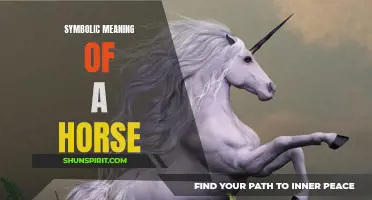
The Vegvisir, also known as the Viking Compass, is a powerful symbol in Norse mythology that has come to represent guidance and protection for those who wear it. This enchanting concoction of ancient runes serves as a reminder to stay on the right path, even in times of uncertainty or chaos. For centuries, this symbol has held deep significance and continues to captivate modern individuals who seek a sense of direction and security in their lives. Join us on a journey to unravel the hidden meaning behind the Vegvisir, as we dive into the ancient Viking legends and explore the enduring allure of this mystical symbol.
What You'll Learn
- What does the Vegvisir symbol mean in Norse mythology?
- How was the Vegvisir symbol traditionally used by Vikings?
- Is the Vegvisir symbol still used today, and if so, in what context?
- Are there any variations or interpretations of the Vegvisir symbol?
- How does the Vegvisir symbol relate to other Norse symbols and mythology?

What does the Vegvisir symbol mean in Norse mythology?
In Norse mythology, the Vegvisir symbol, also known as the Viking compass or Norse compass, is an ancient Icelandic magical stave that is believed to guide travelers through rough weather and help them find their way. The word "Vegvisir" translates to "wayfinder" or "signpost" in Icelandic. This symbol is considered to be a powerful and protective symbol that brings luck and wards off evil spirits.
The Vegvisir symbol consists of eight arms radiating from a central point, forming a circular shape. It is often depicted in a symmetrical manner, with each arm ending in three branches. The symbol is usually drawn in black ink, although it can also be seen in various other colors. It is commonly found on ancient Viking artifacts, such as runestones and amulets.
According to Norse legends, the Vegvisir has the ability to show the way in both literal and metaphorical senses. In a physical sense, it is believed to help travelers find their way home, even in unfamiliar territories or during harsh weather conditions. It was particularly useful for Viking sailors who often relied on the stars and natural landmarks to navigate the open seas.
In a metaphorical sense, the Vegvisir is thought to guide individuals through the tribulations and challenges of life. It is believed to help individuals stay focused and stay on the right path, even when faced with difficulties or uncertainty. The symbol is said to provide inner strength, clarity, and determination, helping individuals make the right decisions and avoid getting lost on their life journey.
The Vegvisir symbol has gained popularity in modern times among Norse enthusiasts and those interested in Norse mythology. It is often worn as a talisman or incorporated into tattoos and jewelry to invoke its protective and guiding qualities.
In addition to its function as a wayfinding symbol, the Vegvisir is also associated with magic and spiritual beliefs. It is believed to have the power of warding off evil spirits and protecting its wearer from harm. It is often used in rituals or ceremonies aimed at seeking guidance, protection, and good fortune.
Overall, the Vegvisir symbol holds significant meaning in Norse mythology. It is a symbol of guidance, protection, and luck, helping individuals find their way through both physical and metaphorical journeys. Whether used as a talisman or admired as a piece of ancient Norse culture, the Vegvisir continues to be a symbol of strength and resilience for many today.
Decoding Goku's Symbols: Unveiling the Hidden Meanings Behind Dragon Ball's Iconic Hero's Emblems
You may want to see also

How was the Vegvisir symbol traditionally used by Vikings?
The Vegvisir symbol is an ancient Norse symbol that is often referred to as the "Nordic Compass" or the "Viking Compass." It is believed to have been used by Vikings as a navigational aid to help them find their way during their long sea voyages.
The word "Vegvisir" is derived from the Icelandic words "vegur" meaning road or way, and "visir" meaning guide or pointer. The symbol consists of eight arms radiating out from a central point, with various runic symbols inscribed on each arm. It is often depicted within a circle or a protective ring, and is said to offer the holder protection and guidance, even in unfamiliar territories.
According to Viking folklore, the Vegvisir symbol was believed to have magical properties that would enable the user to never get lost, regardless of the weather conditions or the unfamiliarity of the terrain. It was believed to have the power to create a "spiritual compass" that would help the Vikings find their way home, even when they were far out at sea or deep within uncharted lands.
The Vegvisir symbol was typically used by Viking sailors and explorers. Before embarking on a sea voyage, they would inscribe the symbol on a piece of wood or metal and carry it with them for protection and guidance. The symbol was often incorporated into amulets, tattoos, and even carved onto ships so that it could be easily seen by the crew.
Vikings also believed that the Vegvisir symbol had the ability to ward off evil spirits and protect against dangerous creatures, such as sea serpents and mythical sea monsters. It was a symbol of strength, bravery, and protection, and was often carried into battle by Viking warriors.
In addition to its navigational and protective properties, the Vegvisir symbol also had a spiritual meaning for the Vikings. It represented the connection between the spiritual and physical worlds, and was believed to bring luck and fortune to those who carried it. It was a symbol of faith and trust in the gods, and was often used during religious ceremonies and rituals.
Today, the Vegvisir symbol has become popular among those who identify with Viking heritage and Norse mythology. It is often worn as a pendant or incorporated into jewelry, and is believed to bring its wearer luck, protection, and guidance on their own personal journeys.
In conclusion, the Vegvisir symbol was traditionally used by Vikings as a navigational aid to help them find their way during their sea voyages. It was believed to have magical properties that would protect and guide the user, even in unfamiliar and dangerous territories. It represented strength, protection, and a connection between the spiritual and physical worlds. Today, it continues to be a symbol of Viking heritage and is cherished by those who identify with Norse mythology.
Demystifying Messenger Symbols: What Do They Mean and How to Decode Them
You may want to see also

Is the Vegvisir symbol still used today, and if so, in what context?
The Vegvisir symbol, also known as the Viking Compass or Norse Compass, is a runic symbol that originated in ancient Norse culture. Although it fell out of use for many centuries, it has seen a revival in recent times and is now utilized in various contexts.
The Vegvisir symbol is often associated with protection and guidance. According to Norse mythology, it was believed to offer assistance to those who were lost or found themselves in unfamiliar territory. The word "Vegvisir" translates to "wayfinder" or "signpost" in Icelandic, emphasizing its purpose as a guiding symbol.
In modern times, the Vegvisir symbol is primarily used in the form of tattoos and jewelry. Many people choose to get a Vegvisir tattoo as a symbol of protection and as a reminder to navigate through life's challenges. As a result, it has become quite popular among those who identify with Norse mythology or simply appreciate its design.
Additionally, the Vegvisir symbol has made its way into various cultural and commercial contexts. It can be found on clothing, accessories, and even household items. This wide usage is often seen as a way to tap into the growing interest in Viking culture and the symbolism associated with it.
The symbol has also been adopted by some neo-pagan and heathen groups as a representation of their beliefs and practices. These individuals may use the Vegvisir symbol during rituals or ceremonies as a way to connect with their Norse heritage and seek guidance from the spiritual realm.
It is worth noting that the Vegvisir symbol, like other Norse symbols, has been appropriated by certain extremist groups. These groups may use the symbol to promote their own ideologies and beliefs, which are often unrelated to its original meaning. However, it is important to recognize that the symbol itself is not inherently linked to any particular ideology or belief system, and its interpretation can vary depending on the context and individual.
In conclusion, the Vegvisir symbol has experienced a resurgence in popularity in recent years. It is primarily used in the form of tattoos and jewelry as a symbol of protection and guidance. It can also be found in various cultural and commercial contexts, as well as within certain spiritual practices. While its usage by extremist groups may tarnish its reputation to some extent, it is essential to understand the symbol's original meaning and not let its misuse overshadow its rich Norse heritage.
Decoding the Meaning of Match Symbols: What Do They Really Mean?
You may want to see also

Are there any variations or interpretations of the Vegvisir symbol?
The Vegvisir symbol, also known as the Viking compass or the Norse compass, is a popular mystical symbol from Norse mythology that is believed to provide guidance and protection to those who carry it. While the Vegvisir symbol itself is relatively well-known and widely recognized, there are indeed variations and interpretations of it that exist.
The Vegvisir symbol consists of eight arms radiating from a central point, forming a sort of circular compass. In its most common form, the symbol is typically depicted in black ink on a white background. However, some variations may feature different colors or additional embellishments.
One common variation of the Vegvisir symbol includes additional runes or bindrunes incorporated into the design. Runes are ancient characters used in various Germanic languages, and bindrunes are created by combining two or more runes into a single symbol. These additional runes or bindrunes can add personal significance or further magical properties to the Vegvisir symbol.
Another variation of the Vegvisir symbol is the inclusion of other Norse or Viking-inspired motifs, such as ravens, wolves, or ships. These additions can represent different aspects of Viking mythology or have personal meaning for the individual who incorporates them into their Vegvisir symbol.
Additionally, interpretations of the Vegvisir symbol may vary among different individuals or cultures. Some may view it primarily as a tool for physical navigation, while others may see it as a spiritual or metaphysical guide. Some may interpret the eight arms of the symbol as representing the eight cardinal directions, while others may attribute different meanings to each arm based on their personal beliefs or practices.
Ultimately, the variations and interpretations of the Vegvisir symbol allow for individual expression and personal connection to the symbol. Whether someone chooses to incorporate additional runes, bindrunes, or other Viking-inspired motifs, or interprets the symbol in a unique way, the essence and purpose of the Vegvisir symbol remain the same: to provide guidance and protection to the bearer.
Decoding Kubota Tractor Dashboard Symbols: Understanding their Meanings
You may want to see also

How does the Vegvisir symbol relate to other Norse symbols and mythology?
The Vegvisir symbol, also known as the Viking compass or the Norse compass, is a magical symbol from Norse mythology. It is believed to have deep spiritual and protective meaning. In Norse mythology, symbols often held great significance and were thought to possess magical powers.
The Vegvisir symbol is often depicted as a compass made up of eight arms radiating from a central point. It is typically surrounded by a protective circle and is often adorned with various runic symbols. The word "Vegvisir" translates to "guidepost" or "signpost" in Icelandic, indicating that this symbol was associated with guiding and protecting those who used it.
One of the ways that the Vegvisir symbol relates to other Norse symbols and mythology is through its association with the runic alphabet. Runic symbols were an essential part of Norse mythology and were believed to possess magical properties. The Vegvisir often incorporates runic symbols into its design, further enhancing its protective and magical properties.
The Vegvisir symbol is also sometimes associated with the mythological concept of the Huldra, a female creature from Norse folklore. The Huldra is often depicted as a beautiful, seductive woman with a long tail, and she is known to possess mystical knowledge and power. The Vegvisir symbol, with its ability to guide and protect, may have been used by those seeking the knowledge and wisdom of the Huldra.
Additionally, the Vegvisir symbol is often associated with the concept of luck and fortune in Norse mythology. In Norse culture, luck was considered a supernatural force that could be influenced by symbols and rituals. The Vegvisir symbol may have been used to attract good luck and protect against misfortune in various aspects of life, such as travel, hunting, and battle.
The Vegvisir symbol's connection to other Norse symbols and mythology is also seen in its association with the god Odin. In Norse mythology, Odin was the chief god and was associated with wisdom, knowledge, and magic. He was known for his ability to travel between worlds and gain secret knowledge. The Vegvisir symbol, with its ability to guide and protect, may have been seen as a representation of Odin's wisdom and guidance.
Overall, the Vegvisir symbol is deeply intertwined with Norse mythology and symbolism. Its connection to other Norse symbols, such as the runic alphabet, the Huldra, luck, and Odin, further enhances its mystical and protective qualities. Whether used as a physical talisman or as a visual representation, the Vegvisir symbol continues to hold a significant place in Norse mythology and modern Viking-inspired culture.
The Ancient Hopi Symbols: Unveiling Their Meaning and Spiritual Significance
You may want to see also
Frequently asked questions
The Vegvísir symbol, also known as the Viking Compass or the Norse Compass, is an ancient Norse symbol that is believed to serve as a guide for travelers. It is said to be a magical symbol that helps people find their way through rough weather or unfamiliar terrain.
The Vegvísir symbol is typically depicted as a complex and intricate design, consisting of several interlocking lines and geometric patterns. It resembles a compass and is often surrounded by other magical symbols, such as runes or staves.
The origins of the Vegvísir symbol are not entirely clear, but it is believed to have originated in Iceland during the Middle Ages. It is often associated with Norse mythology and Viking culture, as Iceland was settled by Norse explorers and settlers during that time.
The Vegvísir symbol is commonly used in modern times as a decorative motif, often seen in tattoos, jewelry, and other forms of artwork. Some people also believe that wearing or displaying the symbol can bring them protection and good fortune on their journeys.
Yes, the Vegvísir symbol is closely associated with navigation and finding one's way. It is often believed to have the power to guide travelers safely through unfamiliar territories and help them avoid getting lost. This is why it is often referred to as the Viking Compass or Norse Compass.







